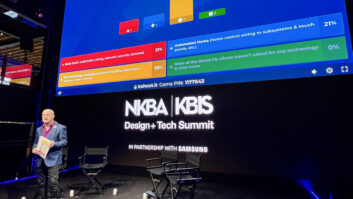In the rapidly changing world of consumer electronics, it is nearly impossible to stop long enough to assess the significance of the products that we work with every day. Over the course of a couple weeks, however, I attended two events where technology from our industry was put into historical context.

The first occasion was a luncheon honoring Lutron’s founder Joel Spira for his donation of materials from his company’s 50-year history to the Smithsonian’s National Museum of American History. The second event involved legendary filmmaker Francis Ford Coppola’s endorsement of SIM2’s video projectors during a press conference at the director’s 1,650-acre Rubicon Estate in Rutherford, California.
Although SIM2 provided greater star power, there is no doubt that Lutron’s event offered more historical punch. During the private luncheon at the iconic Washington D.C. museum, Spira and his wife Ruth, officially donated an early version of the original solidstate Capri dimmer manufactured by Lutron in September 1964. Also part of the donation is a retail display featuring the fully functional dimmer and other Lutron dimmers and lighting-control systems.
Sometimes, it feels like the CEDIA channel is working in a vacuum of early adopters and niche brands that the broader consumer market has never heard of. That’s why learning that the Lutron donation would join other artifacts in the museum’s Electricity Collection, such as experimental light bulbs from Thomas Edison, made our industry seem so much more significant.
The SIM2 experience stood out in a different way. The event was essentially the official launch of an advertising campaign featuring Coppola’s endorsement of SIM2’s projectors. Coppola, who has used the Italian manufacturer’s projectors in his post-production facility for the past two years, said he came to SIM2 looking for a projector after doing a lot of research into his options. He clarified, however, that he was not paid or approached by an agent to endorse the products. He just really likes them, he said.
Now, other than from a celebrity standpoint, how does this merit equal billing to the Lutron event? The answer, again, has a little to do with a broader recognition of our industry, but it also comes from an observation I made inside Coppola’s Rubicon Estate museum.
The museum showcases the history of the Coppola family and that of the winery itself (it once housed the famous Inglenook brand), but it also features an impressive shrine to early motion picture projection artifacts. Upon seeing this thorough collection, it was clear to me that Coppola not only knows a lot about the art of filmmaking, but also the technology used to display his work.
His films used to be projected through celluloid, but now Coppola has proudly made a complete transition to digital, which is why he wanted to work with SIM2. Maybe one day SIM2 projectors will be behind glass in his museum’s collection. For now they are just a very relevant addition to the historical timeline of technology.







